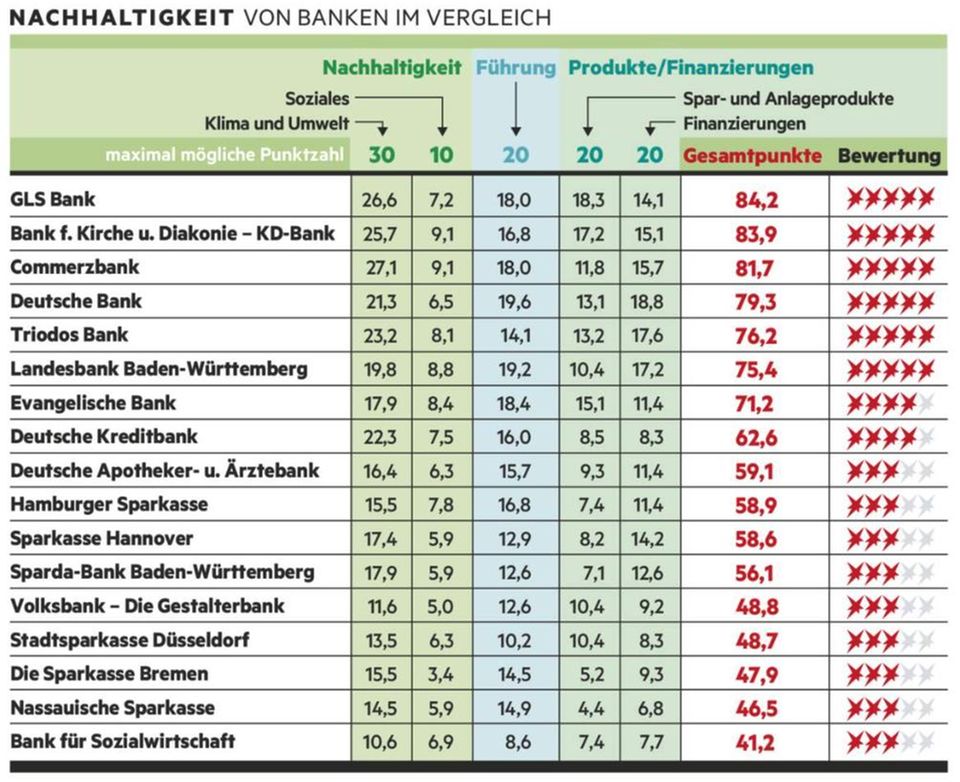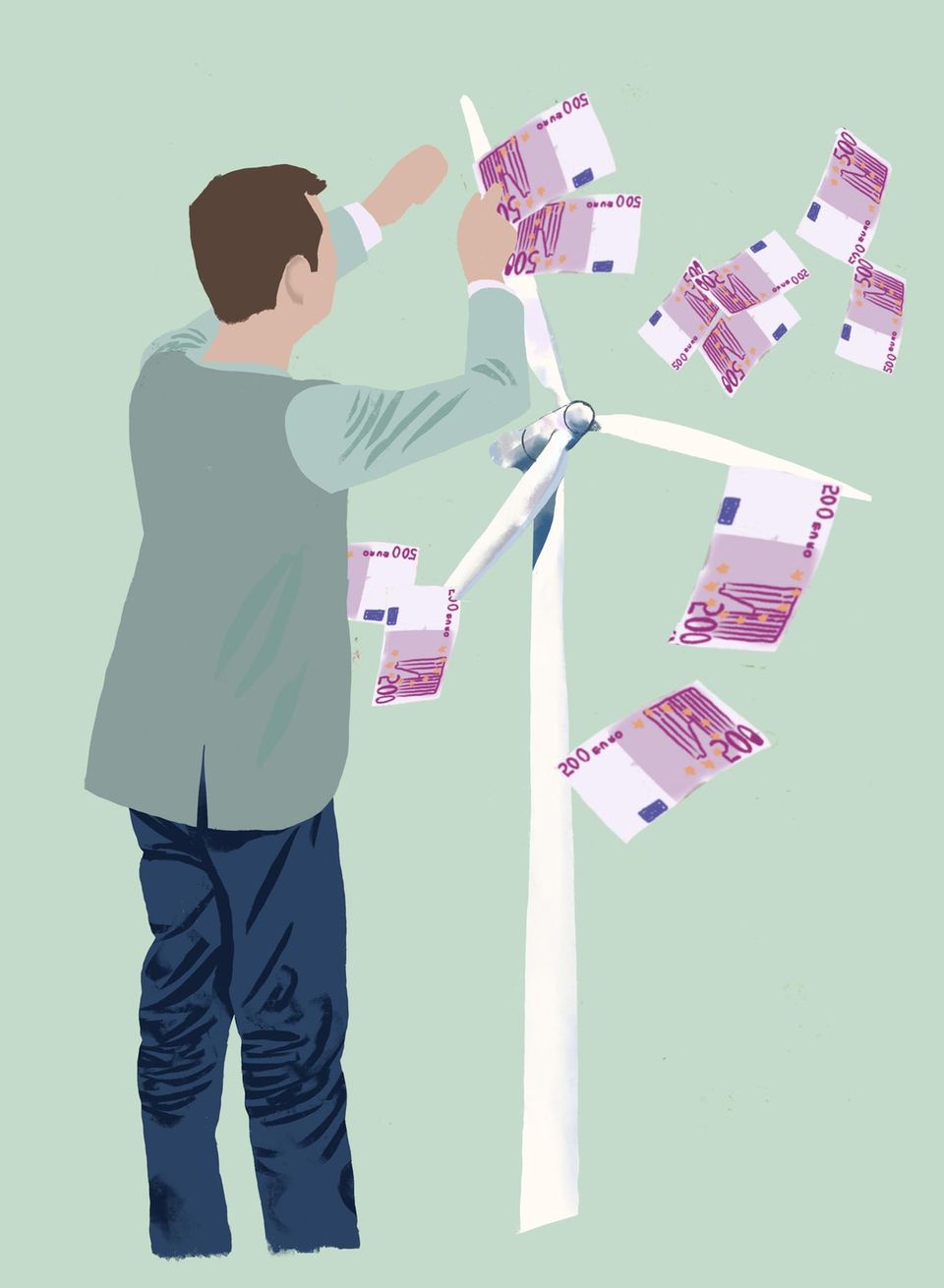Accounts, funds, loans – suddenly all banks want to be sustainable. An exclusive study for the star shows how good the financial institutions really are.
The woman on stage wears snake print leggings and a pink sleeveless top. “Concentrate consciously on breathing,” she says, “we breathe out deeply. And in.” Next up is the back. “Then we want to round ourselves up,” commands the trainer, “stretch once, round once – that’s really good for the spine.” Hundreds of arms go up and then down in the hall of the congress center in Bochum. After ten minutes, the gymnast finishes the Pilates exercises: “Let all tension sink into the floor.”
And this is supposed to be the general meeting of a bank?
Yes. It is the annual meeting of the owners of GLS Bank. The abbreviation means community bank for loans and gifts. The name already makes it clear that this is not a perfectly normal financial institution. It’s a credit union. The shareholders are called members. The two-day meeting at the end of September is not only used for annual reports and elections to the supervisory board, it is also about the effect of the money that is invested here and then multiplied as a loan to homes, organic farms or Waldorf schools. The focus should always be on people – and it is also good for them to relax their mind and body between two program points.
The financial institute founded in 1974 already had sustainability in mind when the word was still a technical term from forestry. According to this, only as much wood should be felled as can grow back through reforestation.
Banks in the sustainability check
Today everyone wants to be ecological, green or sustainable in some way – especially savings banks and banks. This is partly due to new rules from the European Union. But also in the power of the market: savers want ethical investments, shareholders want to invest in climate-neutral companies, and professionals prefer employers who do something to save the world.
For the individual, however, it is difficult to see through what to make of the banks’ assurances. Many institutes present thick reports, but the information is hardly comparable for the layperson. The institute for asset accumulation (IVA) has therefore taken a close look at the sustainability of the industry for the star. The experts examined not only corporate governance, but also product offerings and lending.
It is no great surprise that the GLS Bank and other socially oriented institutes do particularly well. But big banks are now also scoring points when it comes to sustainability – including even Deutsche Bank. Its investment subsidiary DWS was recently accused of greenwashing – i.e. presenting itself as greener than it really is. DWS denies that, the investigation is still ongoing, but the boss has since been replaced. Therefore, the study authors saw no reason to deduct points. “The rules of good corporate governance took effect,” says Gabriel Layes from the IVA, “a problem arose and consequences were drawn.”
In any case, one result of the study is that there is no lack of good intentions. All participating banks have formulated a sustainability strategy, and top management is also responsible for implementation. But when it comes to the salaries of the bank bosses, there is a lack of consistency: only half of the bonuses are at least partially dependent on it. “The other half is giving away good opportunities to set the right incentives for a more sustainable bank,” says expert Layes.
Those who think they are on the right track are more likely to take part in such a study. From this perspective, some results are disappointing. Only half of the banks have formulated concrete and differentiated targets for reducing their emissions by 2025. After all, 61 percent instruct their employees to organize business trips in a climate-friendly manner. And all banks promote the environmentally friendly mobility of their employees – for example through job tickets or company bicycles.

Deficits in product offering
Of course, what is particularly important for customers is what is available online or in the branch. 72 percent of the banks have a sustainable one giro or Saving account. Even slightly more state that they also offer corresponding pension plans. But the IVA experts still see room for improvement when it comes to implementation. Only half also have guidelines for the design of pension products, and only 20 percent require the insurance companies to comply with them. Here savers should ask persistently.
The situation is similar with investing. 83 percent of banks say they actively sell funds that are classified as sustainable under EU rules. The keyword that customers need to pay attention to is “disclosure regulation”. Funds according to “Article 8” take ecological and/or social aspects into account when selecting their investments. Many well-known, large funds have sorted themselves here. The degree of consequence is very different. “Article 9” funds are not better per se, only one aspect is highlighted here, such as reducing greenhouse gas emissions.

You can often recognize the offers by the abbreviation ESG. This stands for Environment, Social, Governance – i.e. for environment, social issues and corporate management. Inexpensive index funds are based on the MSCI World, for example. SRI stands for Socially Responsible Investment.
In the product rating, the GLS cuts in the star-Study best off. The Stiftung Warentest recently rated the GLS Bank equity fund very positively when comparing green investments.
The transparency of financing at the institute from Bochum is astounding. The website shows that the Stäbelow wind farm near Rostock received a loan of five million euros or the Wundertüte day care center in Warpe, Lower Saxony, received exactly 106,240.68 euros for its expansion.
The members in the Bochum Congress Hall celebrate bank boss Thomas Jorberg as a pioneer. The wave of sustainability in the financial sector is almost a little scary for him. “There’s still something going on,” he says in his annual report, looking at the competition: “It’s easier to see a lighthouse on the level.”
The method
Study:
According to the specifications of stareditors, the Institute for Wealth Creation (IVA) asked 53 financial institutions to take part in the study in July. The large financial groups (private banks, savings banks, cooperative banks) and institutions specializing in sustainability were taken into account. The selection was based on total assets and market relevance. Banks that have not been examined can also be sustainable. The survey was carried out using a questionnaire and our own research.
Valuation:
Three areas were examined and weighted.
1. Bank sustainability: 60 percent (environment: including CO2 footprint, mobility concepts, climate neutrality; social: including diversity, working time models, employee development; corporate management: including ESG goals, governance structures, compliance)
2. Product offering: 20 percent (sustainable account offerings, other investment products and retirement savings solutions)
3. Financing portfolio: 20 percent (eligibility criteria for loans, financing projects with a positive impact, distribution of the loan portfolio).
A maximum of 100 points could be achieved.
The overall rating is based on the following scale:
75 points and more: 5 stars
60 to 74.9 points: 4 stars
40 to 59.9: 3 stars
25 to 39.9: 2 stars
up to 24.9: one star
Providers that have received at least three stars are published.
Transparency:
We only work with test partners with a high level of expertise. This means that the IVA is also in demand as a service provider in the financial sector. However, the neutrality of data collection and analysis is always guaranteed. The editors decided on the rating scheme. The winning companies have the option of one star-Acquiring seals. For more detailed information on the terms of these seals, see .
Source: Stern
Jane Stock is a technology author, who has written for 24 Hours World. She writes about the latest in technology news and trends, and is always on the lookout for new and innovative ways to improve his audience’s experience.




